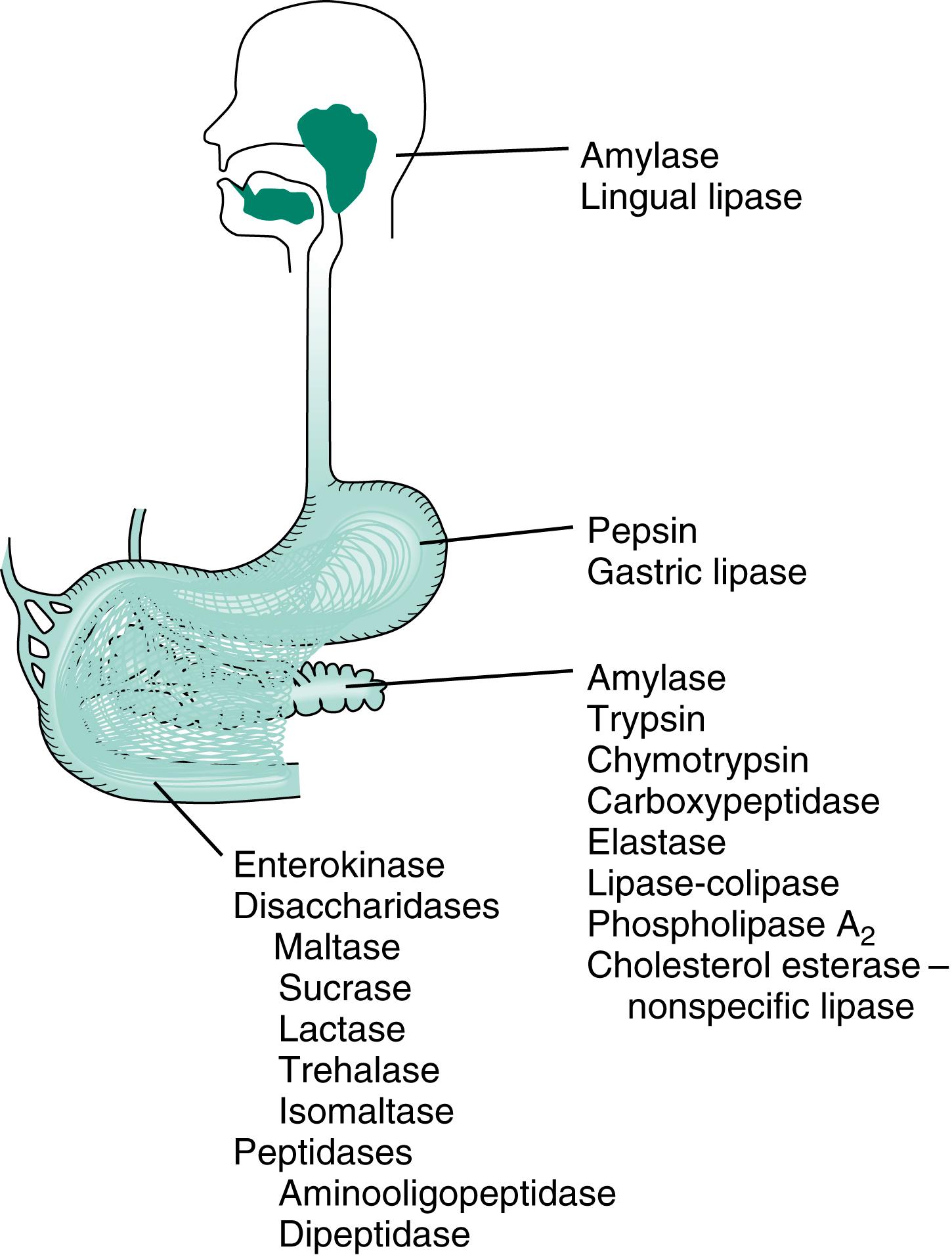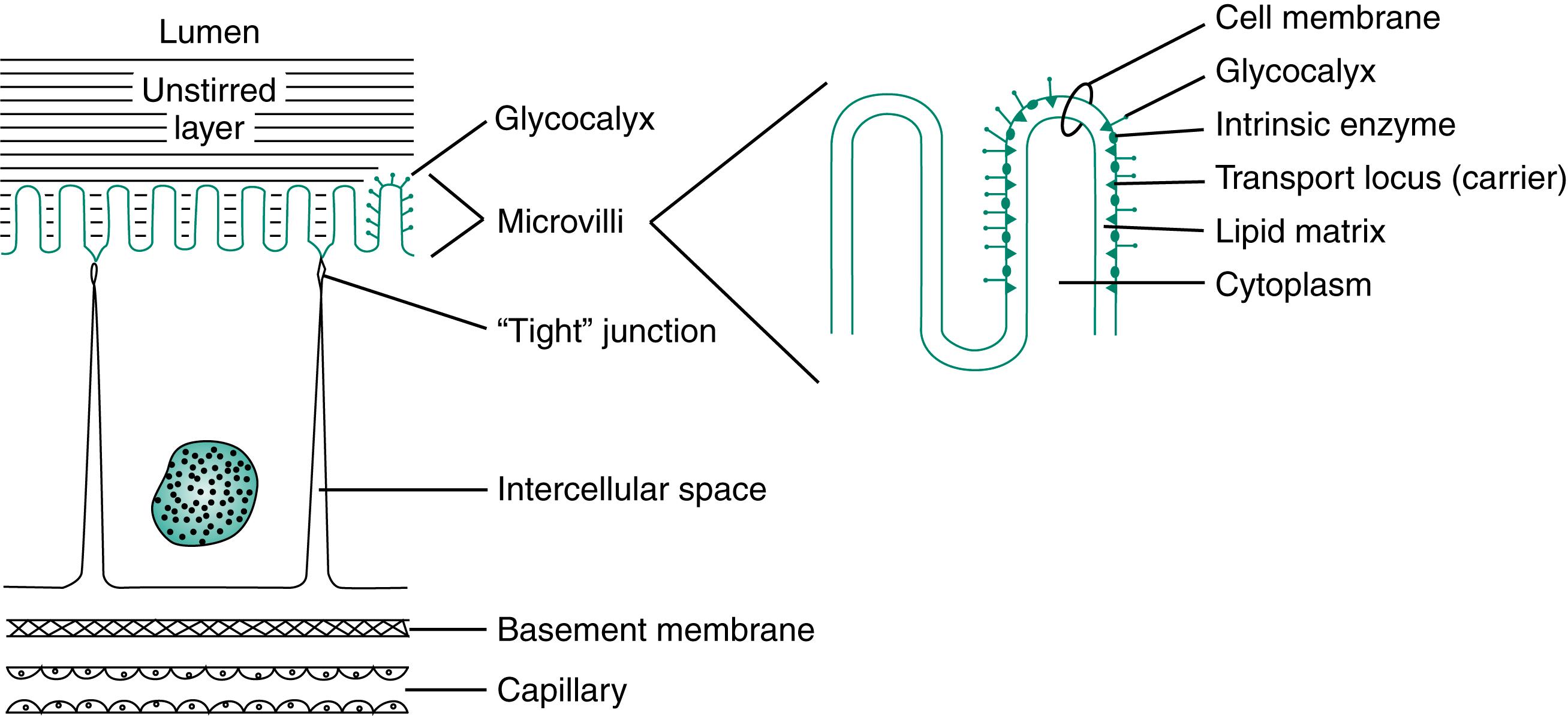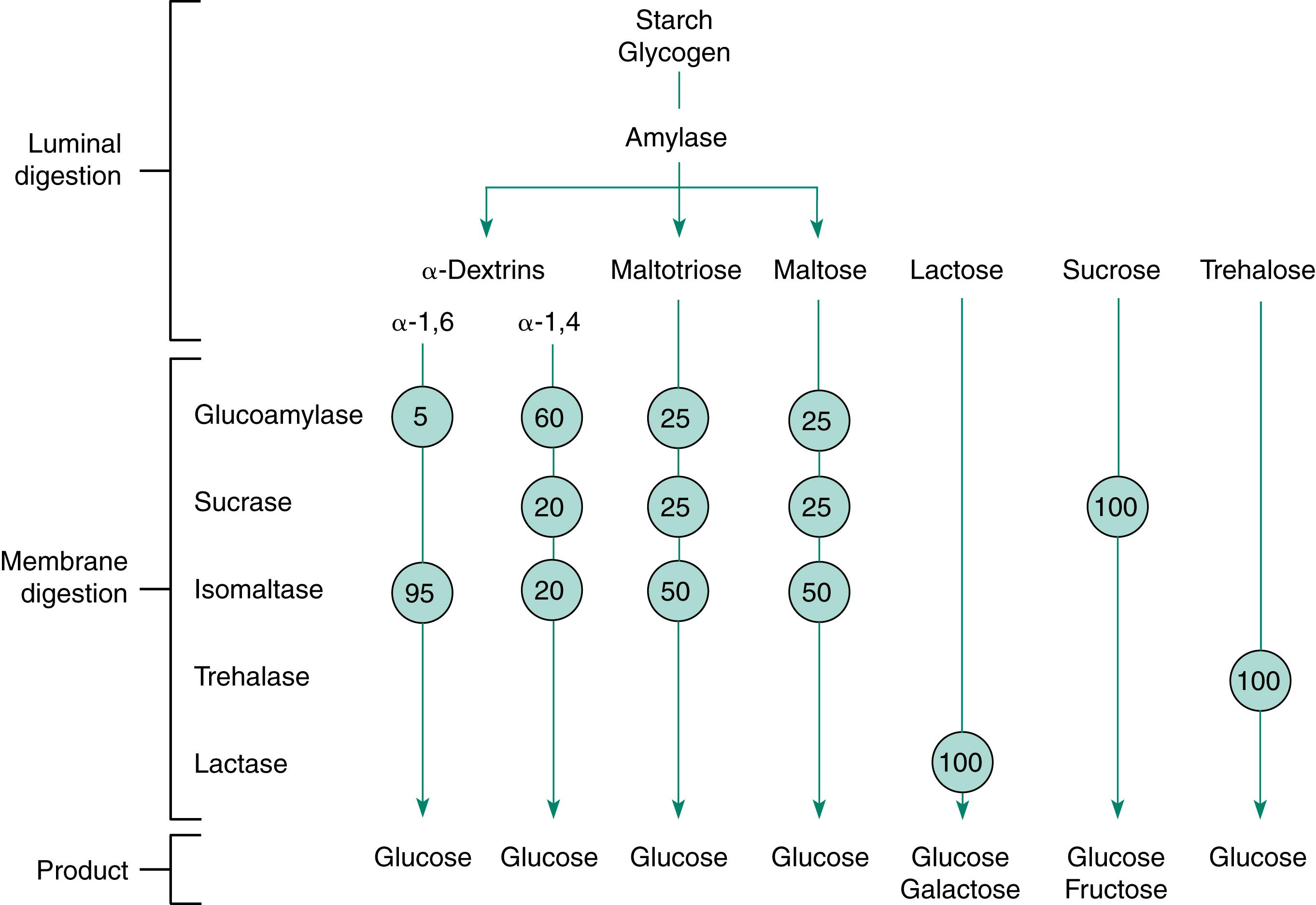Physical Address
304 North Cardinal St.
Dorchester Center, MA 02124
Indicate the sources, types, and functions of the primary digestive enzymes.
Explain the transport processes and the pathways involved in the absorption of nutrients.
Describe the processes involved in the digestion and absorption of carbohydrates.
Indicate problems that may result in the malabsorption of carbohydrates.
Describe the digestion and absorption of proteins.
Explain the role of trypsin in protein digestion and how it may be involved in the development of pancreatitis.
Understand the significance of carriers for dipeptides physiologically and clinically.
Discuss the processes involved in the digestion and absorption of the various lipids including the roles of micelles and chylomicrons.
Discuss disorders that may lead to steatorrhea (excessive fat in the stool).
Motility and secretion are regulated to ensure the efficient digestion of food and absorption of nutrients across the mucosa of the gastrointestinal (GI) tract. This chapter explains how food is broken down into small absorbable molecules and how these products are transported into the blood.
Food assimilation takes place primarily in the small intestine and is aided by anatomic modifications that increase the luminal surface area—Kerckring’s folds, villi, and microvilli. The microvilli are prominent on the apical surface of columnar epithelial cells or enterocytes and occur to a lesser extent on goblet cells. Collectively the microvillous regions constitute the brush border .
Several cell types make up the intestinal epithelium. Students of digestive and absorptive physiology are most familiar with enterocytes and goblet cells . Enterocytes function in digestion, absorption, and secretion. Goblet cells secrete mucus. The function of mucus is not clear but may be related to physical, chemical, and immunologic protection. Both enterocytes and goblet cells are derived from a common stem cell within the intestinal crypts. Enterocytes and goblet cells become differentiated as they move upward from the base of the crypt, and their characteristics are expressed more strongly as they migrate farther up the villus. As they reach the tip of the villus, the cells are extruded and become a component of the succus entericus. Following division of the stem cells, some daughter cells migrate to the base of the crypt where they differentiate into Paneth cells , which are part of the mucosal defenses against infection. These cells secrete several agents that destroy bacteria (lysozymes and defensins) or produce inflammatory responses (tumor necrosis factor-α [TNF-α]).
In humans, the time needed to replace the entire population of epithelial cells (the cell turnover time) is 3 to 6 days. Cell proliferation, differentiation, and maturation are influenced by GI hormones, growth factors, other endocrine substances, and the nature of the material in the lumen. These processes are also altered by starvation, irradiation, and the loss of a portion of the bowel. The rapid proliferative rate of the intestinal mucosa makes it vulnerable to radiation and chemotherapy, procedures used to treat cancer. Despite the interplay between a basic dynamic process and the extrinsic factors that affect epithelial development, under normal conditions the mucosal appearance remains relatively constant.
Digestion is the chemical breakdown of food by enzymes secreted by glandular cells in the mouth, chief cells in the stomach, and the exocrine cells of the pancreas, or enzymes bound to the apical membranes of enterocytes. Although some digestion of carbohydrates, proteins, and fats takes place in the stomach, the final breakdown of these substances occurs in the small intestine.
The enzymes important in digestion are summarized in Fig. 11.1 . Luminal or cavital digestion results from enzymes secreted by the salivary glands, stomach, and pancreas. Significant chemical degradation of food is also carried out by hydrolytic enzymes associated with the small intestinal brush border. Hydrolysis by these enzymes is termed contact or membrane digestion . Membrane digestion is a more acceptable term, because contact digestion connotes activity by exogenous enzymes that become adsorbed on the epithelial surface. Membrane digestion refers to hydrolysis by enzymes synthesized by epithelial cells and inserted into the apical membrane as integral components. The half-life of membrane-bound enzymes (e.g., oligosaccharidases) is shorter than that of the epithelial cells. Thus breakdown and resynthesis occur several times during the life of a single cell.

Digestion and absorption of essentially all major dietary products take place in the small intestine. Despite the degradation of colonic contents by bacteria, physiologically important digestion does not occur in the colon. Nonetheless, absorption in this organ is impressive. A practical illustration is that some medications administered as rectal suppositories are systemically functional. During periods of health the principal substances absorbed from the colon are water and electrolytes. However, life is possible without this organ, as evidenced by patients who thrive after colectomy.
Although the brush border is the site of activity for a number of digestive enzymes, it is also the barrier that must be traversed by nutrients, water, and electrolytes on the way to the blood or lymph. The terms transport and absorption often are used interchangeably to mean the movement of materials from the intestinal lumen into the blood. Secretion implies movement in the opposite direction.
Conceptually the plasma membrane of the enterocyte is often considered the only factor restricting the free movement of substances from the gut lumen into the blood or lymph. However, transmural movement actually takes place over a complex pathway. This is conveyed schematically in Fig. 11.2 and includes (1) an unstirred layer of fluid , (2) the glycocalyx (“fuzzy coat”) covering the microvilli, (3) the cell membrane, (4) the cytoplasm of the enterocyte, (5) the basal or lateral cell membrane, (6) the intercellular space, (7) the basement membrane, and (8) the membrane of the capillary or lymph vessel.

An outstanding property of the enterocyte membrane is its capacity to control the flux of solutes and fluid between the lumen and blood. This process involves several mechanisms. Pinocytosis occurs at the base of microvilli and may be a major mechanism in the uptake of protein. Other uptake processes include passive diffusion , facilitated diffusion , and active transport . In the case of passive diffusion, the epithelium behaves like an inert barrier, and the particles traverse this cell layer through pores in the cell membrane or through intercellular spaces. Lipid-soluble substances can diffuse through lipid portions of the membrane. The tight junction between apposing enterocytes (see Fig. 11.2 ) forms a mechanical seal that prevents mixing of interstitial fluid with luminal contents. This seal, however, is relatively leaky to ions and water in certain regions of the intestine, thus allowing some exchange between the lumen and intercellular spaces.
Alterations in intestinal functions in response to a variety of factors are well documented. Functional adjustments that maintain homeostasis or allow an animal to cope better with its environment are termed adaptations. The quality and degree of adjustment depend on the type of environmental stimulus encountered. Clinical situations in which the capacity to adapt is magnified are small bowel resection and bypass. Until recently physicians knew only that a patient subjected to one of these operations underwent an initial phase of undernutrition, steatorrhea, and acidic diarrhea and that these symptoms tended to be alleviated with time. Relief from the symptoms is believed to be attributable to adaptations. For example, after proximal bowel resection or bypass, the remaining segment undergoes hyperplastic changes accompanied by enhancement of particular absorptive and digestive functions. Adaptation is limited in some circumstances. This point is illustrated by the fact that the carrier-mediated absorption of vitamin B 12 and bile salts is confined strictly to the terminal ileum. Other regions of the GI tract cannot compensate if the absorptive capacity for these compounds in the ileum is lost.
With certain genetic abnormalities, such as lactase deficiency , the capacity to adapt is lost. Lactase deficiency and also pancreatic and intestinal diseases of varied origin contribute to maldigestion and malabsorption.
The average daily intake of carbohydrates, which account for approximately 50% of the calories ingested, is approximately 300 g in the United States. Starch comprises approximately 50% of the total, sucrose approximately 30%, lactose 6%, and maltose 1% to 2%. Trehalose, glucose, fructose, sorbitol, cellulose, hemicellulose, and pectins make up most of the remainder. Starch is a high-molecular-weight compound consisting of two polysaccharides, amylose and amylopectin. Amylose is a straight-chain polymer of glucose linked by α-1,4-glycosidic bonds. The repeating disaccharide unit is maltose. Amylopectin , a plant starch, is the major form of carbohydrate in the diet and is similar to amylose; however, in addition to 1,4- linkages there is a 1,6-linkage for every 20 to 30 glucose units. Glycogen is a high-molecular-weight polysaccharide similar to amylopectin in molecular structure but having considerably more 1,6-linkages. Maltose and trehalose are dimers of glucose in 1,4- and 1,1-linkages, respectively. Sucrose is a disaccharide consisting of 1 mole (mol) of glucose bound at the number 1 carbon to the number 2 carbon of fructose. Lactose is 1 mol of galactose bound at the number 1 carbon to the number 4 carbon of glucose in a β-linkage.
Luminal digestion of starch begins in the mouth with the action of salivary α-amylase and ends in the small intestine through the action of pancreatic α-amylase, which is 94% homologous to salivary amylase. Human salivary and pancreatic amylases have optimum activities near neutral pH and are activated by chloride (Cl – ). Although salivary amylase is destroyed by acid in the stomach, some enzymatic activity occurs within a bolus of food while it remains unmixed with acid in the orad stomach. Most starch digestion, however, occurs in the small intestine. Hydrolysis occurs not only in the lumen but also at the surface of epithelial cells because some amylase is adsorbed to the brush border.
Amylase attacks only the interior α-1,4-bonds of amylose, thus yielding maltose and the trisaccharide maltotriose. Hydrolysis of amylopectin and glycogen yields similar products in addition to α-limit dextrins ( Fig. 11.3 ). The latter are oligosaccharides of glucose, formed because the α-1,6- linkages and the α-1,4- bonds near the 1,6- linkages are resistant to amylase. As much as one-third of amylopectin cannot be hydrolyzed by amylase. The average α-limit dextrin contains 5 to 10 glucose residues and is rapidly hydrolyzed by membrane-bound enzymes.

Products of amylase action on starch and other major dietary sugars are hydrolyzed by brush border carbohydrases. The process begins with the removal of α-limit dextrins ( Fig. 11.4 ). Glucoamylase is the most active enzyme, but sucrase and isomaltase also cleave these bonds. The glucose residues are removed sequentially from the nonreducing ends until a 1 to 6 branch point is reached. This bond is hydrolyzed by isomaltase, which also is called α-dextrinase. Sucrase cleaves 100% of sucrose to yield glucose and fructose. All lactose is broken down into glucose and galactose by lactase. Trehalase breaks the α-1,1- bonds of trehalose into glucose. Sucrase, lactase, and trehalase break down sucrose, lactose, and trehalose, respectively. Thus the only products of sugar digestion are glucose, galactose, and fructose.

Sucrase and isomaltase occur together as a molecular complex. The finding that congenital deficiencies of sucrase and α-dextrinase occur together reveals a close functional relationship between these two enzymes. In humans, sucrase-isomaltase is a compound molecule, one unit with absolute specificity for sucrose and one for the α-1,6- linkage of an α-limit dextrin.
In general the small intestine has a large disaccharidase reserve, so much that the rate-limiting step in sugar assimilation is not digestion but the absorption of free hexoses following hydrolysis. Under normal circumstances the major portion of sugar assimilation is complete in the proximal jejunum. The human GI tract does not possess cellulase capable of digesting the β-glucose bonds of cellulose and hemicellulose. These carbohydrates account for the undigestible fiber present in the diet.
Become a Clinical Tree membership for Full access and enjoy Unlimited articles
If you are a member. Log in here